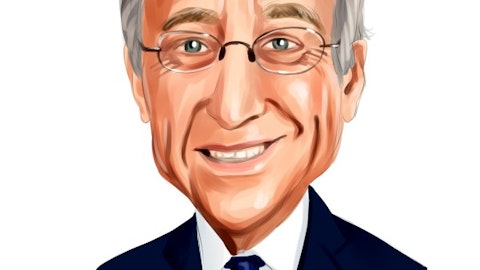We would obviously expect to see that organic growth be, roughly speaking, maybe a two thirds to one third price to volume split. So again, I think, relatively consistent with the same message you’ve seen before, but yeah, we do expect to see continued good momentum into Q2.
Julian Mitchell : That’s helpful. Thank you, Vik. Then just my quick follow up on the second quarter. So, if the revenue sort of up sequentially, the margins maybe down sequentially is that the point? I mean, often you have revenue up sequentially second quarter, and then sequential operating leverage with it, and EPS up sequentially. But, if you’re saying that, EPS can be up sequentially, it puts the first half at 50% of the year’s earnings, which I think is abnormal seasonality, but I think you’re saying seasonality is normal this year. So, just maybe help us understand on that second quarter EBITDA and EPS.
Vikram Kini: Yeah, yeah, and Julian maybe I’ll keep it relatively high level, but I think the way we would think about it here is obviously Q1 really strong performance, particularly on the margin side of the equation, over 27% EBITDA margin profile. I think the way we should think about it here is, we do expect revenue and EBITDA dollars to grow sequentially. We would expect EBITDA margins to continue to be healthy. It’s probably worth noting when you think about that in the translation down to EPS, we did benefit a little bit in the first quarter from a tax rate perspective, which we do expect to normalize a little bit. So that will create a little bit of some of that sequential noise from Q1 to Q2, but again nothing that we’d point to from an operational perspective.
We continue to expect good, healthy flow through, good margins and yes, we do — just to be very clear, we do expect to see sequential improvement on the revenue and the EBITDA dollar side of the equation.
Julian Mitchell : Great, thank you.
Operator: Your next question comes from a line of Jeff Sprague from Vertical Research Partners. Your line is open.
Jeff Sprague : Hey, thank you. Good morning.
Vicente Reynal: Morning.
Jeff Sprague : Maybe could we just unpack actually the Q1 margins and ITS a little bit more, Vicente mentioned, i2V and price cost and everything, but obviously a very impressive performance in the quarter. I’d like to get a little more color there on what happened. Just on the change in incrementals, Vik, I assume the FX change helps that number a little bit. Maybe speak to, is there any change in kind of the underlying expectation for incrementals for the year?
Vicente Reynal: Hey, Jeff, on the ITS, yeah, I mean, we’re very pleased with the performance and you heard the commentary that solid gross margin expansion and that’s basically kind of what we saw also on the ITS side. I mean, phenomenal gross margin expansion and driven by a lot of the initiatives that we have been talking about over the past few years, call it this i2V, the Innovative Value Activities as well as some of the restructuring that we also did in the fourth quarter that we saw also benefiting here early on in Q1. So, again, speaks pretty highly in terms of what the team continues to do to control what we can control, and the fact that, what is very exciting and very pleasing is to see clearly getting to that 30% but even more so at this kind of still fairly highly inflationary market situation.
So, meaning that as we eventually over time continue to see the inflationary that continues to also help expand our margin even further. We were very pleased with the, I mean, not surprised but also excited to see that continued performance on that.
Vikram Kini: Yeah, then Jeff to the second part of your question on the incremental. The way I would probably think about it is just, frankly a continuation of what Vicente spoke to. When you think about the biggest drivers that Vicente spoke to, whether it be the i2V, the direct material kind of productivity initiatives, frankly, really solid price cost, flow through where as we’ve messaged coming into the year, we expected inflationary headwinds kind of move sideways. That’s frankly what we saw and we saw good price realization in the first quarter. There’s really no expectation that should be dramatically different for the balance of the year. Then the restructuring actions, which just to even provide a little bit more color, we took some targeted restructuring actions at the tail end of last year.
You actually saw we also did some in Q1 of this year. So again, that’s all leading to that kind of incrementals that we would expect for the full year, which is getting you now closer to that 50%.
Jeff Sprague: And then I think coming out of this quarter right, those of us who haven’t dialed in ILC yet, will. Just any – assuming kind of a mid, late quarter close, should we expect some EPS benefit in 2024 or are there kind of integration and other costs that would kind of negate that?
Vikram Kini: Yeah, Jeff, let me take that one. So yeah, to your point, just to be very clear, obviously our guidance does not include ILC Dover as the deal has not closed. To Vicente’s kind of earlier comments, we do expect to close later in the quarter. So again, we would expect nominal, if any, impacting Q2. As far as the balance of the year, which I’m really now focused on the second half, we would expect to see some nominal EPS impact. But again, as we get through the quarter and frankly as we give our next earnings, where we expect that, the deal will close later this quarter, we’ll give you a little bit more color for the back half of the year as we kind of get to deal closure. But again, I’d say nominal EPS impact as we sit here right now for the back half of the year.
Jeff Sprague: Great, thank you.
Operator: Your next question comes from a line up, Rob Wertheimer from Melius Research. Your line is open.
Rob Wertheimer: Thanks, good morning everybody. I guess I’d like to take it a little bit more towards the strategic end and thinking about what ILC Dover opens up for you, which you kind of talked about in the prepared remarks on acquisition, on runway and on deals, and more specifically, is that kind of a landmark deal where you can tuck in other things that valuations that look either more like your traditional or in between the two? What does the pipeline build look like? How are you thinking about the timeline and so forth? And if I may, just one last one. Does that sort of satisfy the larger, I’ll add a second half leg to the stool kind of things in the backlog or is it potentially more out there? Thank you.




